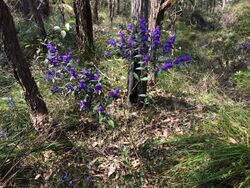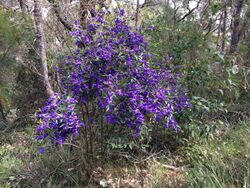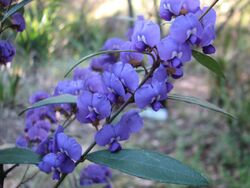Biology:Hovea elliptica
| Hovea elliptica | |
|---|---|

| |
| Scientific classification | |
| Kingdom: | |
| (unranked): | |
| (unranked): | |
| (unranked): | |
| Order: | |
| Family: | |
| Genus: | |
| Species: | H. elliptica
|
| Binomial name | |
| Hovea elliptica | |
Hovea elliptica, commonly known as the tree hovea[2] or karri blue bush,[3] is an ornamental plant in the Fabaceae family that is native to Western Australia. This plant was cited as Hovea Celsi in Description des plantes rares cultivees a Malmaison et a Navarre by Aimé Jacques Alexandre Bonpland.
Description
The erect and slender shrub or small tree typically grows to a height of 0.4 to 3 metres (1 to 10 ft)[2] It is usually single stemmed and the young branches are covered in spreading often rust coloured hairs. The stipules are narrow triangular and around 1 millimetre (0.039 in) in length.[4] The alternately arranged leaves have an elliptical blade to around 7.5 centimetres (3.0 in) in length.[5] The species has purple or blue flowers that appear between August and December in its native range.[2] The pea shaped flowers are arranged in short clusters among the leaf axils.[5] The axillary inflorescencess contain one to seven flowers. The seed pods that form later are ovoid to ellipsoid in shape and are 0.8 to 1.2 cm (0.31 to 0.47 in) in length and 0.8 to 1.3 cm (0.31 to 0.51 in) wide. The olive brown seeds within have an elliptic shape and 3.8 to 5.1 mm (0.15 to 0.20 in) in length and 2.8 to 3.1 mm (0.11 to 0.12 in) wide.[4]
Taxonomy
The species was first formally in 1808 as Poiretia elliptica by James Edward Smith in 1808 in the work Characters of Platylobium, Bossiaea and of a new Genus named Poiretia as published in Transactions of the Linnean Society of London. It was later transferred to the Hovea genus by the botanist Augustin Pyramus de Candolle in 1825 in the work Leguminosae. Prodromus Systematis Naturalis Regni Vegetabilis. Numerous synonyms are known including Goodia simplicifolia as described by Kurt Polycarp Joachim Sprengel in 1827, Phusicarpos elliptica by Jean Louis Marie Poiret in 1816 and Platychilum celsianum by Jean-Claude Michel Mornant de Launay in 1819.[6]
Distribution
It occurs on sand dunes, slopes ridges and granite outcrops in the South West and Great Southern regions of Western Australia where it grows in clay, loamy, sandy and gravelly lateritic soils[2] often rich in organic matter.[4] Usually part of the understorey in jarrah, marri and karri forest communities[5] and is often associated with Bossiaea aquifolium subsp. laidlawiana and Hovea chorizemifolia.[4]
Cultivation
It is sold commercially as seedlings or in seed form, the seeds germinate readily but need to be scarified or pre-treated with boiling water.[5] The plant prefers a well drained soils and an open sunny or partly shaded position.[3] It is drought tolerant but frost tender.[5]
References
- ↑ "Hovea elliptica". Australian Plant Name Index (APNI), IBIS database. Centre for Plant Biodiversity Research, Australian Government, Canberra. http://www.anbg.gov.au/cgi-bin/apni?TAXON_NAME=Hovea+elliptica. Retrieved 2009-08-02.
- ↑ 2.0 2.1 2.2 2.3 "Hovea elliptica". FloraBase. Western Australian Government Department of Parks and Wildlife. https://florabase.dpaw.wa.gov.au/browse/profile/3965.
- ↑ 3.0 3.1 "Karri Blue Bush (Hovea elliptica)". Gardenworld. https://www.gardenworldshop.com.au/seeds-and-bulbs/australian-wildflower-seeds/karri-blue-bush-hovea-elliptica.html. Retrieved 21 September 2018.
- ↑ 4.0 4.1 4.2 4.3 J.H.Ross. "Notes on Hovea". Royal Botanic Gardens, Victoria. https://www.rbg.vic.gov.au/documents/Muelleria_7(1),_p21-38,_Ross,_notes_Hovea_2.pdf. Retrieved 21 September 2018.
- ↑ 5.0 5.1 5.2 5.3 5.4 "Hovea elliptica". Australian Seed. https://www.australianseed.com/shop/item/hovea-elliiptica-. Retrieved 21 September 2018.
- ↑ "Hovea elliptica (Sm.) DC.". Atlas of Living Australia. Global Biodiversity Information Facility. https://bie.ala.org.au/species/http://id.biodiversity.org.au/node/apni/2915992#names. Retrieved 21 September 2018.
- Bonpland, A. J. A. (1813). Description des plantes rares cultivees a Malmaison et a Navarre. http://www.anbg.gov.au/biography/bonpland-aime-jacques.html.
- Pink, A. (2004). Gardening for the Million. Project Gutenberg Literary Archive Foundation. http://www.gutenberg.org/etext/11892.
- Rowan, E. (c. 1906). Flower and bird paintings. National Library of Australia. http://nla.gov.au/nla.pic-an6730567.
External links
Wikidata ☰ Q5664146 entry




